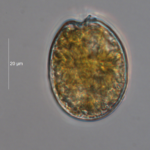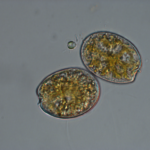Detected Species
-
HAB Species
- Diatoms
- Dinoflagellates
- Cyanobacteria
- Raphidophytes
- Haptophytes
-
Non-toxic Species
- Diatoms
- Dinoflagellates
Contact Us:
Mihaela D. Enache, Ph.D., Project Manager & Co-PI, Research Scientist I, Division of Science and Research, NJDEP (mihaela.enache@dep.nj.gov)
Ling Ren, Ph.D., PI, Research Assistant Professor, College of Science, George Mason University (lren2@gmu.edu)
Prorocentrum lima
Morphology
Cells ovoid to round, oval, or oblong oval. 30–57 μm in length; 21–46 μm in width.
Toxins and toxicity
Produce okadaic acid, DTX1 and DTX2 (dinophysistoxins), can cause Diarrhetic Shellfish Poisoning (DSP) toxicity in mussels and oysters, sometimes associated with ciguatera outbreaks.
Ecology
Benthic, and periphytic attached to macroalgae.
Distribution and Occurrence
Cosmopolitan (temperate and tropical areas). Harmful blooms caused by this species detected in Europe, Africa, North America, Central America, Asia, Oceania, Indian Ocean. In this study, P. lima was abundant in REF-2, OMWM-1, and OMWM-2 from November to January, March to June, and August to September.
References
Steidinger, K.A. 2018. Chapter III. Toxic and potentially harmful dinoflagellates in the Gulf of Mexico. In Steidinger, K.A. & Meave del Castillo, M.E. [Eds.] Guide to the Identification of Harmful Microalgae in the Gulf of Mexico, Volume I: Taxonomy. St. Petersburg, FL, p. 211342. http://myfwc.com/research/redtide/research/scientific-products/


